Abergwynolwyn is a village situated at the confluence of the Nant Gwernol and the Afon Dysynni, about two and a half miles south-west of Tallyllyn, on the road to Tywyn. The village lies in the historic county of Merionethshire, and is situated near Castell y Bere, Llanfihangel-y-Pennant. Its main industry was slate mining, but the industry disappeared when the quarry closed after WW2. The Parish Church, which is dedicated to St. David, is situated to the south of the village. Outside its porch is a newly restored War Memorial, which commemorates the men of the village who fell during both World Wars.
The Great War, 1914-1918
Thomas Hugh Davies, Private, 290490, Royal Welsh Fusiliers. Thomas was born in Abergwynolwyn in around 1878. He married Margaret Ellen Griffiths in 1899, and the couple resided at 21, Llanegryn Street, Abergynolwyn. Thomas enlisted into the 7th Battalion, Royal Welsh Fusiliers following the outbreak of war. He was posted to the 3/7th Battalion, Royal Welsh Fusiliers initially, but was later posted to France, joining the 15th Battalion, Royal Welsh Fusiliers, which was attached to 114 Brigade, 38th (Welsh) Division. He probably joined the battalion following its move from the Somme, where the Division had seen terrible fighting at Mametz Wood, to the Canal Bank sector at Boesinghe, north of Ypres. The Division soon got to work improving the trenches and defences at Boesinghe, whilst carrying out sporadic trench raids, as well as undergoing the usual routine of rotation in the trenches over the coming months, whilst building up to the opening of the Third Battle of Ypres on 31 July 1917. In the days leading up to the battle, the various infantry battalions of the division had been out of the line, training and preparing for the forthcoming offensive. On 23 July 1917 the 15th RWF moved back into the line on the Canal Bank, relieving the 16th RWF, to begin a short spell in the line prior to the battle. On 27 July 1917 the battalion received reports that a RFC aircraft had spotted that the Germans opposite had withdrawn, so ‘A’ Company of the 15th RWF was ordered to cross No Mans Land to see if the reports were true. Unfortunately, the Germans had not withdrawn, and the men came under heavy fire, forcing them to withdraw after suffering severe casualties. Thomas was among 45 men of the battalion killed in action needlessly during the day. The 39-year-old is buried in Dragoon Camp Cemetery, Belgium.
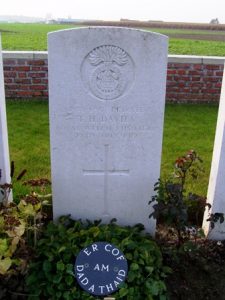
William John Evans, Private, 22804, Welsh Regiment. William was the son of John and Jane Evans, of Abergwynolwyn. He married Ceridwen Jones, of 20, Llanegryn Street, Abergwynolwyn in 1907. By 1911 the couple was living at 23, Penmaesglas, Penygraig with their three children, where William was working as a coal miner. He enlisted at Tonypandy into the 13th Battalion, Welsh Regiment early in 1915. The battalion was known as the Second Rhondda Battalion, as most of its recruits were drawn from the South Wales valleys. It moved to Rhyl, joining 129 Brigade, 43rd (Welsh) Division. On 29 April 1915 the formation became renumbered 114 Brigade, 38th (Welsh) Division, and moved to Winchester in August for final training, before landing in France from 2 December 1915. The entire Division moved to the Nursery sector at Fleurbaix, where it was initiated into trench warfare. During June 1916 the Division marched south to the Somme, and on 7 July 1916 attacked Mametz Wood. The initial attack failed, and it was three days later, on 10 July, that a fresh attack was mounted. After two days of heavy hand to hand fighting within the wood, the Germans withdrew, and the battered Welshmen moved via Hébuterne to Boesinghe, on the Yser Canal, where the infantry battalions began the usual pattern of trench rotation: front line, reserve, and rest, interspersed with trench raids and trench consolidation. Throughout January 1917 the 13th Welsh was busy, supplying working and wiring parties on a daily basis, while the Division worked on improving its defences. William was wounded during this period, and evacuated to the 46th Casualty Clearing Station at Proven, where he died of his wounds on 28 January 1917, aged 36. He is buried in Mendinghem Military Cemetery, Belgium.
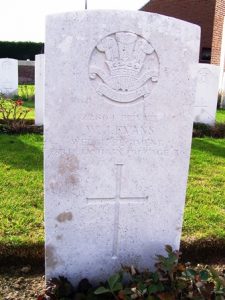
David Gomer Griffiths, Private, 285128, South Wales Borderers. David was the son of Robert Lewis Griffiths and Ellen Griffiths, of 3, Water Street, Abergwynolwyn. He enlisted at Abergwynolwyn into the 7th Battalion, Royal Welsh Fusiliers on 26 February 1913. The battalion was a Territorial unit, which mobilised for war at Newtown in August 1914, as part of North Wales Brigade, Welsh Division and moved to Conway until the end of the month, before moving to Northampton. In December the Division moved to Cambridge and then in May 1915 to Bedford, where the Division was numbered and the formation became 158 Brigade, 53rd (Welsh) Division. On 19 July 1915 the entire Division sailed from Devonport for Imbros and on 9 August 1915 landed at Suvla Bay. David was invalided home from Gallipoli, and upon his recovery embarked at Southampton for France on 13 June 1917. He was transferred to the 1st Battalion, Monmouthshire Regiment, but posted to the 2nd Battalion, South Wales Borderers, which was attached to 87 Brigade, 29th Division. By now the Division had moved to the Ypres Salient from Arras, and was preparing to take part in the Third Battle of Ypres, training behind the lines. On 15 August 1917 the 2nd SWB moved into the battle area, crossing the Steenbeek, which had been cleared by the 38th (Welsh) Division two weeks previously, and moved to positions near Sentier Farm, near Langemarck. On the following morning the battalion attacked, but suffered heavy casualties before being relieved. The battalion then rested behind the lines for several weeks again, before moving back into the line near the Broembeek, north of Langemarck, on 30 September, and on 5 October 1917 relieved three battered battalions in the front line. David was killed in action during the relief that day. The 27-year-old is buried in Bleuet Farm Cemetery, Belgium.
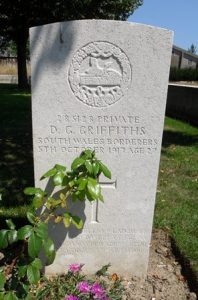
William Humphreys, Lance Corporal, 61030, Royal Welsh Fusiliers. William was the son of Jacob and Leah Humphreys, of 10, Water Street, Abergynolwyn. He enlisted at Dolgellau into the Royal Welsh Fusiliers, and after completing his training was posted to France, joining the 2nd Battalion, Royal Welsh Fusiliers, which was attached to 33 Brigade. In February 1918 the 2nd RWF was transferred to 115 Brigade, 38th (Welsh) Division, which was near Armentieres. At the end of March 1918, the Division was rushed south to relieve the battered 2nd and 47th Divisions in the line north of Albert, at Bouzincourt Ridge. Over the coming months the Division carried out several raids in order to gain control of the high ground overlooking the Ancre Valley, and then the ground on the west bank of the Ancre, before crossing the flooded valley on 21 August 1918 and beginning its offensive against Thiepval Ridge, as part of the great Allied offensive on the Western Front. Over the coming days the Division captured Pozieres, Mametz Wood and Delville Wood, areas which had cost tens of thousands of lives to take in 1916, and pushed slowly towards the Canal du Nord. By 12 September the Division had reached Gouzeaucourt, and began preparing to carry on the offensive the following day. At 9.20 on 13 September 1918 the Germans launched a desperate counter-attack under an artillery bombardment. Some Germans managed to get into the trenches held by the 2nd RWF, but after several hours of desperate fighting the Germans withdrew. William was among fifteen men killed during the fighting that day. The 20-year-old is buried in Gouzeaucourt New British Cemetery, France.
Private H. Jones. This man cannot presently be identified.
John Meyrick Jones, Leading Aircraftman, 38235, Royal Air Force. John was the son of Hugh Jones and Mary Melina Jones (nee Griffiths), of 10, Tanybryn Street, Abergynolwyn. He enlisted into the Royal Flying Corps on 17 July 1916, and remained in the service when the RFC merged with the RNAS in March 1918 to form the Royal Air Force. John continued to serve with the Royal Air Force after the war, but early in 1919 contracted influenza, and died on 21 February 1919, aged 31. He is buried in Fedw Cemetery, Abergwynolwyn. John is not commemorated on the Abergwynolwyn memorial.
John Rees Jones, Private, 8204, Dorsetshire Regiment. John was born in Abergwynolwyn in 1881, the son of Rees and Catherine Jones. By 1891 his father had moved the family to 24, Gwendoline Street, Llangeinor, after gaining work as a labourer in a colliery. John married Ellen Llewellyn at Blaengarw in 1903, and the couple lived at Standard View, Ynyshir, where John worked as a Colliery House Keeper. He enlisted at Ynyshir at the outbreak of war into the 3rd Battalion, Dorsetshire Regiment, and after completing his training embarked for France on 25 March 1915, joining the 1st Battalion, Dorsetshire Regiment, which was attached to 15 Brigade, 5th Division. John joined the battalion at Ypres, where it had been since October 1914. The 5th Division played a part in the capture of Hill 60 on 17 April 1915, during John’s first major action. The Hill afforded the Germans a fine view point over the city of Ypres, and was a vital position. The Royal Engineers blew a series of mines beneath the hill, which caused some casualties to the attacking troops of the 5th Division, but the German front line had been overwhelmed. The Germans attempted a counter-attack, but failed, and the Divisional troops began to consolidate their gains. The Germans then began to rain down artillery fire on the hill, and on 18 April a series of German counter-attacks were again beaten off. On 1 May 1915 the Germans launched a series of gas attacks against the defenders of Hill 60, the worst of which came on 5 May 1915, and the surviving front line troops were forced to evacuate their trenches. Heavy fighting raged all through the day, and over the coming days. John had been killed in action during the desperate fighting of 5 May 1915. The 33-year-old has no known grave and is commemorated on the Ypres (Menin Gate) Memorial, Belgium. John is not commemorated on the Abergwynolwyn memorial.
William Jones, Private, 2606, Royal Welsh Fusiliers. William was the son of Owen and Mary Jones, of Pandy, Abergwynolwyn. He enlisted at Abergwynolwyn into the 7th Battalion, Royal Welsh Fusiliers soon after the outbreak of war. The battalion was a Territorial unit, which mobilised for war at Newtown in August 1914, as part of North Wales Brigade, Welsh Division and moved to Conway until the end of the month, before moving to Northampton. In December the Division moved to Cambridge and then in May 1915 to Bedford, where the Division was numbered and the formation became 158 Brigade, 53rd (Welsh) Division. On 19 July 1915 the entire Division sailed from Devonport for Imbros and on 9 August 1915 landed at Suvla Bay. The infantry moved off the beaches into the bush, but due to a lack of maps and no knowledge of the terrain, many of the units became disorientated, and the situation became chaotic. William was killed in action at some time over the following days. Some records state 10 August, but officially he is recorded as being killed in action on 11 August 1915. The 21-year-old has no known grave and is commemorated on the Helles Memorial, Gallipoli.
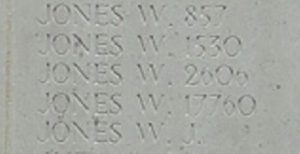
Evan Morgan, Private, 291462, Royal Welsh Fusiliers. Evan was the son of Cadwaladr and Margaret Morgan, of 3, Lichfield Terrace, Abergwynolwyn. He worked as a Quarryman prior to enlisting at Dolgellau into the 7th Battalion, Royal Welsh Fusiliers on 14 December 1915 and was placed on the Army Reserve. Evan was mobilised on 9 February 1916 and after completing his training embarked for Egypt on 10 June 1916. Evan was then posted to the 8th Battalion, Royal Welsh Fusiliers, which had just left Egypt for service in Mesopotamia, and was attached to 40 Brigade, 13th (Western) Division. The Division came under orders of the Tigris Corps, and then took part in the attempts to relieve the besieged garrison at Kut. However, after these efforts failed and Kut fell, the British force in the theatre was built up and reorganised and the Division took part in the lengthy campaign to drive the Turks out of Mesopotamia, in terrible conditions. Turkey signed an Armistice on 31 October 1918, and less than two weeks later Germany surrendered. Evan suffered two bouts of fever before being sent home for demobilisation, and was on his way back through France when he fell ill, and was hospitalised at the 2nd General Hospital at Le Havre. He died of pneumonia there on 13 March 1919, aged 28. Evan was buried in Ste. Marie Cemetery, Le Havre, France. He is also commemorated on the Dolgellau memorial.
Abram Owen, Private, 290464, Royal Welsh Fusiliers. Abram was the son of Lewis and Catherine Owen, of 13, Llanegryn Street, Abergwynolwyn. He lived at 15, Wood Street, Mardy prior to the war and worked as a Colliery Repairer. Abram was already a member of the 7th Battalion, Royal Welsh Fusiliers when war broke out, as he had enlisted at Abergwynolwyn on 26 February 1913, and had attended two annual TA summer camps. The battalion was a Territorial unit, which mobilised for war at Newtown in August 1914, as part of North Wales Brigade, Welsh Division and moved to Conway until the end of the month, before moving to Northampton. In December the Division moved to Cambridge and then in May 1915 to Bedford, where the Division was numbered and the formation became 158 Brigade, 53rd (Welsh) Division. On 19 July 1915 the entire Division sailed from Devonport for Imbros and on 9 August 1915 landed at Suvla Bay. The Division saw heavy fighting over the coming days, then suffered a terrible winter in the trenches, with weather so bad that a torrential downpour once washed bodies out of graves into the trenches. The Division was eventually evacuated from Gallipoli in December 1915, moving to Egypt to join the EEF, and helped guard the Suez Canal before taking part in operations to drive the Turks out of the Sinai. The EEF then turned its attention onto driving the Turks out of Palestine, and on 26 March 1917 launched its first offensive against the coastal city of Gaza, which guarded the road to Jerusalem. Initial gains during the day were lost when the assaulting divisions lost touch with each other and communication broke down when a thick fog cloaked the battlefield. A further assault on Gaza was launched on 17 April, which again failed, so the EEF was reorganised, and Sir Edmund Allenby assumed command, before a third offensive was launched on the night of 1-2 November on a wider front, running from Gaza to Beersheba. The Turkish line was at last broken, and a general advance was ordered on 5 November. Abram was killed in action on the following day, 6 November 1917, during an assault to capture the Sheria water system. The 27-year-old is buried in Beersheba War Cemetery, Israel.
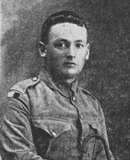
Arthur Price, Private, 16083, Royal Welsh Fusiliers. Arthur was born at Abergwynolwyn Police Station on 12 October 1888, the son of Police Constable Richard Price and Elizabeth Price. By 1901 the family had moved to Blaenau Ffestiniog, after his father had been transferred there. Arthur worked as a Butcher at Ffestiniog prior to the war. He enlisted along with his brother Thomas into the 16th Battalion, Royal Welsh Fusiliers soon after the outbreak of war. raised at Llandudno by the Welsh National Executive Committee from a cadre from the 13th Battalion, joining 128 Brigade, 43rd (Welsh) Division and trained in North Wales before moving to Winchester in the summer of 1915, where the formation became renumbered 113 Brigade, 38th (Welsh) Division. The Division moved to France on 2 December 1915 and moved to the Nursery Sector near Fleurbaix for trench initiation alongside the Guards Division. The Division then held a sector of the line near Cuinchy before marching south to the Somme sector in June 1916 to take part in the assault on Mametz Wood. The first attack on the wood was launched on a two-battalion front on 7 July, but failed, and the Divisional Commander, Sir Ivor Philipps, was replaced before the Division attacked again on a two Brigade front on 10 July 1916. After two days of brutal hand-to-hand fighting, the north edge of the wood was reached before the battered Division was relieved, and spent a month at Hébuterne before taking over the Canal Bank sector of the line at Boesinghe, north of Ypres. The infantry battalions of the Division then began the usual routine of rotation in the trenches, front line, reserve and rest over the coming months. On 5 October 1916 the 16th RWF relieved the 15th RWF in the front line to begin a routine spell in the trenches. Arthur was among a handful of men wounded over the coming days. He was evacuated back to the 46th Casualty Clearing Station at Proven, where he died of his wounds on 13 October 1916, aged 28. He was buried in Mendinghem Military Cemetery, Belgium. Arthur is not named on the Abergwynolwyn memorial.
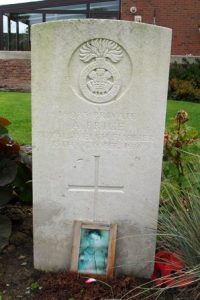
David Edward Pugh, Private, 266616, Monmouthshire Regiment. David was the son of David and Ann Pugh, of 23, Penrhiwfer Road, Tonyrefail. His father had died prior to the war and the family moved to Maesllan Farm, Llanfihangel-y-Pennant, where David worked as a farmer. He enlisted at Dolgellau into the army on 30 May 1916, and was placed on the Army Reserve. David was mobilised on 31 August 1916, and was posted to the 2nd Reserve Battalion, Monmouthshire Regiment. He married Lizzie Evans, of Llechwedd, Llanfihangel-y-Pennant whilst on leave that summer. David embarked for France at Southampton on 21 December 1916, and was posted from the Base Depot at Le Havre to the 179th Tunnelling Company, Royal Engineers on 9 January 1917. In spring of 1917, the 179th Tunnelling Company moved to the Ypres Canal sector near Boesinghe where it commenced work on dugouts, alongside the 38th (Welsh) Division. Some of these dugouts still survive, namely the Yorkshire Trench, at Boesinghe. David was at work on the Canal Bank when the Germans bombarded the positions with gas shells on 12 July 1917. David was killed during the bombardment that day. The 29-year-old is buried in Essex Farm Cemetery, Belgium.
Walter Edward Pugh, Private, 277437, Manchester Regiment. Walter was born at Wallingford, Berkshire in 1898, the son of George and Sarah Pugh. The family later moved to Penmaenmawr by 1911 and then to The Cottage, Peniarth Uchaf. Walter enlisted into the Royal Welsh Fusiliers, but upon completing his training, was posted to the 2/7th Battalion, Manchester Regiment, which was attached to 199 Brigade, 66th Division. He landed in Boulogne, France with the battalion on 7 March 1917, and the entire Division then concentrated around the area of Aire-sur-la-Lys, before heading to Cambrin. On 19 March 1917 Walter’s battalion moved into the front line for the first time, taking over a section of line on the left of the Cambrin sector. On 21 March 1917, on his third day in the trenches, Walter was killed when a German trench mortar shell hit a dugout he was sharing with some other men. He was 19 years old and is buried in Dud Corner Cemetery, Loos, France.
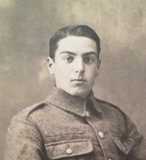
John Rees, Private, 204750, Royal Welsh Fusiliers. John was the son of David and Mary Rees, of Trychiad, Llanegryn. He enlisted at Dolgellau into the 4th Battalion, Royal Welsh Fusiliers, and after completing his training had a spell of leave, visiting his parents in May 1917, before being posted to France, joining the 14th Battalion, Royal Welsh Fusiliers, which was attached to 113 Brigade, 38th (Welsh) Division. He saw his first action during the Divisions assault on the Pilckem Ridge on 31 July 1917, the opening day of the Third Battle of Ypres. Following the ensuing Battle of Langemarck, the entire Division was moved to positions near Armentieres over the winter. After the Germans launched their offensive on the Somme on 21 March 1918, the Division was moved back to the Somme, and took up positions north of Albert, around Aveluy Wood. On 21 April 1918 the 13th RWF moved into the front line facing Bouzincourt Ridge, relieving the 2nd RWF and at 07.30 the following morning 113 Brigade assaulted the Bouzincourt Ridge, with the aim of taking the high ground from the Germans. Heavy casualties were suffered during the day, with the 13th RWF alone suffering almost 270 casualties. John had been wounded during the attack and was evacuated to the 3rd Canadian Stationary Hospital at Doullens, where he died of his wounds on 24 April 1918, aged 20. He is buried in Doullens Communal Cemetery Extension No. 1, France.
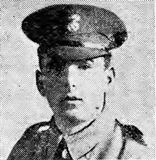
Evan Richards, MSM, Driver, T3/024898, Army Service Corps. Evan was born in Llanegryn in 1893. He worked as a carter at Gwyddffryniau prior to enlisting into the Army Service Corps at the outbreak of war. He married Edith Lucy Bailey, of Grove Cottage, Chalfont St. Giles, Bucks whilst training in the area. He was posted to the 1st Company, 35th Divisional Train, Army Service Corps. The Division moved to France in late January and early February 1916 and saw its first major action during the Battle of the Somme. The Division was found to be somewhat wanting and was rebuilt with men from disbanded yeomanry regiments, before going back into the line early in 1917 and following the German Retreat to the Hindenburg Line. Later in the year the Division moved north to Ypres, and fought at the Second Battle of Passchendaele. By Spring of 1918 it was back on the Somme, and fought during the German Offensive. It was then moved back north, and fought later in the year during the great advance in Flanders, reaching the line of the River Dendre when the armistice halted the fighting at 11.00 on 11 November 1918. Evan was still in France when he sadly drowned during a bathing accident on 4 January 1919, aged 27. He is buried in Bleue-Maison Military Cemetery, Eperlecques, France. He was posthumously awarded the Meritorious Service Medal, in the Peace Gazette of 1919. His widow, Edith, died on 5 January 1962, after having never remarried. (Evan is possibly the correct man, as nobody else named E Richards seems to have resided in the area.)
David Roberts, Private, 2600, Royal Welsh Fusiliers. David was born in Rhosddu, Wrexham, the son of John Roberts and Mary Jane Roberts (nee Morris). Following the death of his father in 1899, his mother moved the family back to her native Abergwynolwyn. David enlisted at Abergwynolwyn into the 7th Battalion, Royal Welsh Fusiliers along with his brother Thomas soon after the outbreak of war. The battalion was a Territorial unit, which mobilised for war at Newtown in August 1914, as part of North Wales Brigade, Welsh Division and moved to Conway until the end of the month, before moving to Northampton. In December the Division moved to Cambridge and then in May 1915 to Bedford, where the Division was numbered and the formation became 158 Brigade, 53rd (Welsh) Division. On 19 July 1915 the entire Division sailed from Devonport for Imbros and on 9 August 1915 landed at Suvla Bay. The infantry moved off the beaches into the bush, but due to a lack of maps and no knowledge of the terrain, many of the units became disorientated, and the situation became chaotic. David was killed in action during the following day, 10 August 1915. The 21-year-old has no known grave and is commemorated on the Helles Memorial, Gallipoli. His brother, Thomas, was killed at Gallipoli four months later, whilst another brother, John Emrys Roberts, died at home of consumption on 22 April 1916.
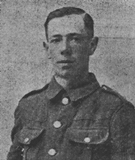
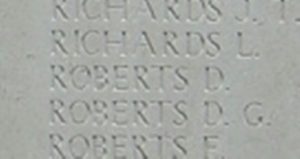
Hugh Roberts, Private, 291515, Royal Welsh Fusiliers. Hugh was born at Llanfihangel-y-Pennant in 1881, the son of William Roberts and Sarah Roberts (nee Rowlands). He was raised in his grandmothers’ home at 17, Llanegryn Street, Abergwynolwyn, but by 1911 was lodging at Harlech, where he worked as a slater. Hugh enlisted into the 7th Battalion, Royal Welsh Fusiliers following the outbreak of war. After completing his training, he was posted to the 24th Battalion, Royal Welsh Fusiliers, which had been formed in Egypt in January 1917 from the dismounted Denbighshire Yeomanry, joining 231 Brigade, 74th (Yeomanry) Division. The newly formed Division took part in the Second and Third Battles of Gaza that year, and in the capture of the city of Jerusalem in December 1917. It then took part in the advance north from Jerusalem over the coming months, before being transferred to France in May 1918. The 24th RWF then transferred to 94 Brigade, 31st Division on 21 June 1918 and from September 1918 took part in the great advance in Flanders, during the Battle of Ypres, and the subsequent Action of Tieghem. At the end of the war the Division was in Belgium, moving from Avelghem to Renaix, before the men started to return home upon discharge. Following his discharge from the army Hugh went to live with his parents at Bryn Meirion, Pontardawe, where his father was working as a Colliery Repairer. He died at Pontardawe on 27 August 1919, aged 38. His remains were conveyed home and he was buried in Fedw Cemetery, Abergwynolwyn. Hugh is not commemorated on the Abergwynolwyn memorial.
Thomas Evan Roberts, Lance Corporal, 2602, South Wales Borderers. Thomas was born in Rhosddu, Wrexham, the son of John Roberts and Mary Jane Roberts (nee Morris). Following the death of his father in 1899, his mother moved the family back to her native Abergwynolwyn. Thomas enlisted at Abergwynolwyn into the 7th Battalion, Royal Welsh Fusiliers along with his brother David soon after the outbreak of war. The battalion was a Territorial unit, which mobilised for war at Newtown in August 1914, as part of North Wales Brigade, Welsh Division and moved to Conway until the end of the month, before moving to Northampton. In December the Division moved to Cambridge and then in May 1915 to Bedford, where the Division was numbered and the formation became 158 Brigade, 53rd (Welsh) Division. On 19 July 1915 the entire Division sailed from Devonport for Imbros and on 9 August 1915 landed at Suvla Bay. The infantry moved off the beaches into the bush, but due to a lack of maps and no knowledge of the terrain, many of the units became disorientated, and the situation became chaotic. The Division suffered a terrible ordeal over the coming months on the Peninsula, especially when the winter storms blew in, and it rained so hard that the bodies of dead men were washed out of their graves and down the trenches. The 7th RWF was preparing for evacuation on 8 December 1915, when a Turkish artillery shell crashed into their billets at 10.15, killing Thomas and one other man. Thomas was 25 years old when he was killed that day, and is buried in Lala Baba Cemetery, Gallipoli. His brother, David, had been killed at Gallipoli four months earlier, whilst another brother, John Emrys Roberts, died at home of consumption on 22 April 1916.
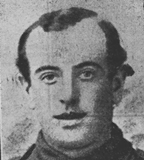
Francis Williams, Private, 2814, Royal Welsh Fusiliers. Francis was the son of Francis and Ann Williams, of 1, Llanegryn Street, Abergwynolwyn. He enlisted at Newtown into the 7th Battalion, Royal Welsh Fusiliers soon after the outbreak of war, and was posted to the 3/7th Battalion, Royal Welsh Fusiliers, at Park Hall Camp, Oswestry, for training. He was then posted to Cambridge to the 4/7th Battalion. Francis died at Cambridge Military Hospital on 7 June 1916, aged 19. His remains were conveyed home for burial in Fedw Cemetery, Abergwynolwyn.
World War Two, 1939-1945
Haydn Egryn Davies, BSc, Serjeant, 1594759, Royal Artillery. Haydn was born on 6 February 1911, the son of William Davies, and of Catherine Davies, of 6, Water Street, Abergynolwyn. He was educated at Aberystwyth University, graduating BSc, before becoming a school teacher at Rhyl, and lived at 36, Garnett Avenue. Haydn enlisted into the Royal Artillery, and was posted to North Africa with the 68th Heavy Anti-Aircraft Regiment, Royal Artillery. His education must have helped him swiftly be promoted to Serjeant. The regiment arrived at Port Said on 22 April 1941, and moved to Tobruk, where most of the battery was captured when the port fell to the Afrika Korps. The regiment was then reformed and after the cessation of the North African campaign served in Malta and Sicily. Haydn was posted as missing, presumed killed in action on or since 28 January 1944. No mention is made where he was killed. The 28-year-old has no known grave and is commemorated on the Alamein Memorial, Egypt.
Owen Meirion Ellis, Gunner, 4079672, Royal Artillery. Owen was born in 1910, the son of Ellis Owen Ellis and Margaret Jane Ellis (nee Owen), of 12, Llanegryn Street, Abergynolwyn. He enlisted into the Monmouthshire Regiment, but was posted to the Royal Artillery, joining the 93rd Heavy Anti-Aircraft Regiment after completing his gunnery training. The regiment was a Territorial Army unit, which had been formed in Cheshire prior to the Great War, and was mobilised in 1938 as a result of the crisis in Germany. It then spent over two years manning the Liverpool Defences, where it played a vital role in attempting to stop the scores of German bomber attacks upon the city and docks during the Blitz. In the spring of 1942 the regiment moved to the south of England, joining the War Office Reserve, and began preparing to move to North Africa. Owen died as a result of an accident whilst in training near Trowbridge on 16 June 1942. The remains of the 32-year-old were conveyed home and he was buried in St. Michael’s Churchyard, Llanfihangel-Y-Pennant four days later.
Joseph Owen, Aircraftman 2nd Class, 1379780, Royal Air Force Volunteer Reserve. Joseph was born on 31 March 1912, the son of Owen and Mary Ann Owen, of Hendre, Abergwynolwyn. Joseph enlisted into the Royal Air Force Volunteer Reserve soon after the outbreak of war, and after completing his training was posted out to the Far East, to RAF Selatar, in Singapore. In December 1941 the Japanese entered the war, launching simultaneous attacks on Pearl Harbour, Malaya, Thailand and Burma, and on 8 February 1942 Japanese troops began landing at Singapore. Heavy fighting raged for several days, before the British surrendered, embarrassingly, on 15 February 1942. Joseph was captured on 8 March 1942, and taken to Malaya POW Camp. He survived three long years in captivity before dying on 11 July 1945, aged 33. Joseph is buried in Jakarta War Cemetery, Indonesia.
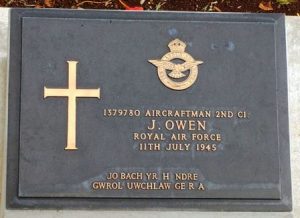
Richard Edward Pugh, Private, 14618137, The Loyal Regiment (North Lancashire). Richard was born in 1923, and lived at Pencarreg, Abergwynolwyn. He had enlisted into the army and was posted to the Loyal Regiment (North Lancashire). Richard was based in Norfolk when he died on active service on 9 March 1944, aged 21. His remains were conveyed home for burial in St. Michael’s Churchyard, Llanfihangel-Y-Pennant (St. Michael) Churchyard.